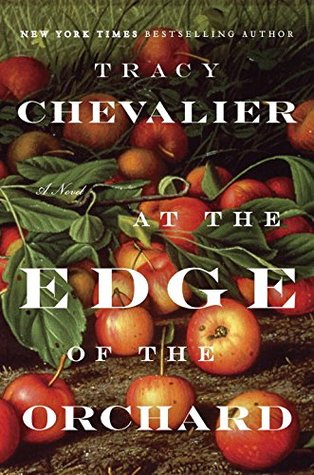Program Coordinator, Mount Diablo Branch of the California Writers Club www.jillhedgecock.com
In At the Edge of the Orchard by Tracy Chevalier (2016, hardcover, Viking, 289 pages, $18.36), James and Sadie Goodenough live a destitute farming life in the harsh, black swampland of Ohio with their five surviving children. Consistent with the 1800s era when sons and daughters rarely lived to see to adolescence; swamp fever claimed five of their ten children.
In a world with few pleasures, James covets one thing above all else: the sweet taste of golden pippin apples. His wife Sadie, however, craves the hard cider made from the sour apples called “spitters.” John Chapman (best known as Johnny Appleseed) is more than happy to encourage Sadie’s thirst for the alcoholic applejack. This turns out to be unfortunate for the Goodenoughs given Sadie’s embittered and vengeful personality. All-out war breaks out in the Goodenough family when it comes time to decide whether to plant more “eaters” or spitters. When James’s wife loses all restraint and decides to take an axe to her husband’s “eater” trees, and everything goes wrong, the youngest Goodenough, Robert, escapes the swampland, leaving two sisters and two brothers behind, including frail Martha.
Robert heads West taking odd jobs and never lingering longer than a few years at any one place. In Texas, he meets Molly, who fancies Robert a lot more than he likes her. When Robert lands in California, Molly tracks him down and their tenuous romance resumes. Here too, Robert meets real-life character, William Lobb, a Cornish plant collector who is employed by Veitch Nurseries. Mr. Lobb gives Robert a job supporting the collection of evergreen trees and seeds to ship back to England and Wales. His occupation becomes an important part of Robert’s life journey as he learns how to be a “tree man.”
Tracy Chevalier has written eight historical novels, including the international bestseller Girl with a Pearl Earring, which was made into an Oscar®-nominated film.
Her skill in capturing the days of old serves this book well. Chevalier does a tremendous job of describing the haphazard birth of San Francisco as a city in the gold rush days, the wonderment of first views of the majestic redwoods, the challenges of ship travel, and the development of the tourist industry surrounding the sequoias of California at Calaveras Big Trees.
The book is revealed through multiple perspectives, including James, Sadie, Robert and Martha Goodenough. Told partially as epistolary (in the form of letters) fiction, the novel describes the difficult circumstances the men and women had to overcome, and the lack of communication available between families in those days, while trying to survive on the American frontier. The novel is a stark reminder of the rigors American pioneers faced in the mid-1800s. I can’t think of a better book to read as an homage to the pioneers that provided the foundation to make California a great state on this Thanksgiving holiday.


